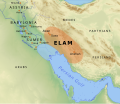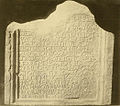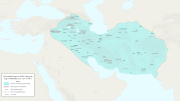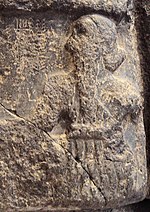The 'Iran Stele' is an ancient Stele from the Assyrian Empire. Tiglath-Pileser III was instrumental in expanding the Neo-Assyrian Empire westward, reaching...
4 KB (303 words) - 06:58, 7 May 2024
A stele (/ˈstiːli/ STEE-lee), or occasionally stela (pl.: stelas or stelæ) when derived from Latin, is a stone or wooden slab, generally taller than it...
36 KB (3,975 words) - 22:55, 7 July 2024
Code of Hammurabi (redirect from Stele of Hammurabi)
inscribed on a basalt stele 2.25 m (7 ft 4+1⁄2 in) tall. The stele was rediscovered in 1901 at the site of Susa in present-day Iran, where it had been taken...
99 KB (9,721 words) - 22:09, 29 June 2024
population. List of biblical figures identified in extra-biblical sources Iran Stele Antiquities of the Jews. 9:11:1 at WikiSource 'Tiphsah' is the name in...
6 KB (737 words) - 17:01, 18 June 2024
Ithobaal II (Tuba‘il) 750–739 BC Name found only on Iran Stele of Tiglath-Pileser III. Gave tribute to Tiglath-Pileser III. Hiram II 739–730 BC Also paid...
8 KB (653 words) - 12:09, 5 October 2023
The Victory Stele of Naram-Sin is a stele that dates to approximately 2254–2218 BC, in the time of the Akkadian Empire, and is now at the Louvre in Paris...
16 KB (1,765 words) - 18:22, 27 April 2024
The Sargon Stele (German: Kition-Stele) was found in the autumn of 1845 in Cyprus on the site of the former city-kingdom of Kition, in present-day Larnaca...
6 KB (704 words) - 14:20, 1 June 2024
officials. List of Assyrian kings Military history of the Neo-Assyrian Empire Iran Stele This estimate assumes Tiglath-Pileser was Adad-nirari III's son. Sometimes...
61 KB (7,507 words) - 06:56, 25 June 2024
Christianity in Iran dates back to 3rd century. Through this time the Christian faith has always been followed by a minority of the population of Iran under its...
51 KB (4,947 words) - 20:31, 15 July 2024
Mesopotamia and was able to carry off many monuments from Babylon, such as the Stele of Naram-Sin. His invasion of Babylon likely had to do with the overthrow...
6 KB (597 words) - 11:15, 6 January 2024
Suez inscriptions of Darius the Great (redirect from Chalouf stele)
lasted from 522 to 486 BCE. The monument, also known as the Chalouf stele (alt. Shaluf Stele), records the construction of a forerunner of the modern Suez Canal...
3 KB (364 words) - 21:31, 16 May 2024
The Stele of Meli-Šipak is an ancient Mesopotamian fragment of the bottom part of a large rectangular stone edifice engraved with reliefs and the remains...
5 KB (587 words) - 18:28, 23 December 2023
Elam (category Ancient history of Iran)
statues of Marduk and Manishtushu, the Manishtushu Obelisk, the Stele of Hammurabi and the stele of Naram-Sin. In 1158 BC, after much of Babylonia had been...
91 KB (9,914 words) - 16:24, 16 July 2024
Naram-Sin of Akkad (section Victory stele of Naram-Sin)
Mountains, expanding his empire up to the Mediterranean Sea. His "Victory Stele" depicts his triumph over Satuni, chief of Lullubi in the Zagros Mountains...
39 KB (4,808 words) - 18:03, 18 June 2024
The Kelashin Stele (Kurdish: کێلەشین) (also Kelishin or Keli-Shin; from Kurdish Language: Blue Stone) found in Kelashin, Iraq, bears an important Urartian-Assyrian...
2 KB (144 words) - 20:52, 1 January 2024
Lemnian language (redirect from Lemnos stele)
It is mainly attested by an inscription found on a funerary stele, termed the Lemnos stele, discovered in 1885 near Kaminia. Fragments of inscriptions...
20 KB (2,248 words) - 22:50, 16 June 2024
The Stele of Vespasian (Georgian: ვესპასიანეს სტელა) is a stele celebrating Roman emperor Vespasian. It was written in Ancient Greek and found in 1867...
4 KB (348 words) - 03:36, 10 April 2024
The Stele of Serapeitis (Georgian: სერაფიტას სტელა) is a funerary stele with bilingual inscriptions written in Ancient Greek and Armazic, a local idiom...
4 KB (366 words) - 16:17, 7 March 2024
Parthian Empire (redirect from Arsacid Iran)
the Arsacid Empire (/ˈɑːrsəsɪd/), was a major Iranian political and cultural power centered in ancient Iran from 247 BC to 224 AD. Its latter name comes...
126 KB (15,616 words) - 15:18, 4 July 2024
statues of Marduk and Manishtushu, the Manishtushu Obelisk, the Stele of Hammurabi and the stele of Naram-Sin. With these trophies, he attempted to give a new...
10 KB (807 words) - 12:44, 2 May 2024
an Ancient Iranian State. Cambridge University Press. p. 104. ISBN 978-0521564960. McKeon, John F. X. (1970). "An Akkadian Victory Stele". Boston Museum...
54 KB (6,272 words) - 16:36, 1 May 2024
and a Seleucid governor. In the 20th century, a stone stele was found near Nahavand. The stele bore a copy of the dynastic cult inscription of Seleucid...
20 KB (1,777 words) - 11:42, 11 July 2024
soldiers in the Battle of Kadesh. Another stele usually cited in conjunction with this one is the "Aswan Stele" (there were other stelae at Aswan), which...
80 KB (9,411 words) - 22:58, 12 July 2024
Lullubi (category Ancient history of Iran)
defeated the Lullubi and their king Satuni, and had his famous victory stele made in commemoration: "Naram-Sin the powerful . . . . Sidur and Sutuni...
17 KB (1,637 words) - 00:54, 14 June 2024
historical records in the 13th century BCE with the Egyptian Merneptah Stele, and, while the worship of Yahweh is circumstantially attested to as early...
35 KB (3,841 words) - 01:27, 9 July 2024
Urartu (category Ancient history of Iran)
Urartian sites in northwest Iran were excavated. In 1976, an Italian team led by Mirjo Salvini finally reached the Kelishin stele, accompanied by a heavy...
78 KB (9,135 words) - 17:44, 9 July 2024
Mahabad (category Iranian Kurdistan)
city in the Central District of Mahabad County, West Azerbaijan province, Iran, serving as capital of both the county and the district. Mahabad first became...
17 KB (1,125 words) - 16:09, 16 July 2024
Rimush (section Victory Stele of Rimush over Lagash)
Lagash and Girsu areas. Possible victory stele of king Rimush (front) (Louvre AO 2678). Possible victory stele of king Rimush (back) (Louvre AO 2678) Detail...
23 KB (2,552 words) - 03:00, 7 June 2024
Administrative Archives Shami statue Statue of Hercules in Behistun Victory Stele of Naram-Sin Ziwiye hoard Roland de Mecquenem (archaeologist) Frank Hole...
3 KB (291 words) - 11:16, 22 March 2024
Qatna to the west in the Levant maintained their independence. However, one stele (stone monument) of Hammurabi has been found as far north as Diyarbekir...
37 KB (4,125 words) - 04:34, 9 July 2024

























